Figures 2.8 (a) and (b) show the field lines of a positive and negative point charge respectively.
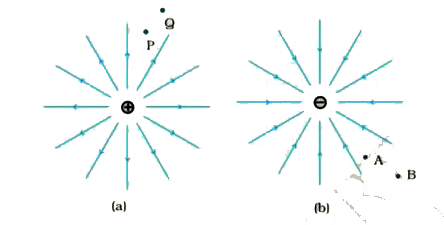
(a) Give the signs of the potential difference VP−VQ:VB−VA.
(b) Give the sign of the potential energy difference of a small negative charge between the points Q and P, A and B.
(c) Give the sign of the work done by the field in moving a small positive charge from Q to P.
(d) Give the sign of the work done by the external agency in moving a small negative charge from B to A.
(e) Does the kinetic energy of a small negative charge increase or decrease in going from B to A?Solution in Gujrati
In V=k(+q)r k(+q) is constant
∴V∝1r
Let the distance of point P from + q charge is rp and distance of point Q is rQ,
rP<rQ
∴VP>VQ⇒VP−VQ>0∴ Positive
and in V=k(−q)r if kq is considered as positive
V∝−1r
Let the distance of point A from - q chargd is .A and distance of point B is rB
rA<rB
∴VA−VB<0
∴VB−Va>0
(b) Potential energy decrease as attraction force acts. Here attraction force acts when negative charge is placed in the field of positive charge and hence potential energy decreases so,
UQ>UP
∴UQ−UP>0 ∴ Positive and when negative charge is placed in the field of negative charge and hence potential energy increases so UA<VB taking from B to A
∴UB−UA>0 ∴ Positive
( c) In moving a positive charge from Q to P, work has to be done against the electric field. Therefore, work done by the field is negative but work done on the field is positive.
(d) In moving a negative charge from B to Aworlc has to be don.e by the external agency. It is positive.
(e) Due to force of repulsion on the negative charge, velocity decreases and hence the lcinetic energy decreases in going from B to A.
Topper's Solved these Questions
- ELECTROSTATIC POTENTIAL AND CAPACITANCEBOOK - KUMAR PRAKASHANCHAPTER - ELECTROSTATIC POTENTIAL AND CAPACITANCEEXERCISE - Section B ( Numerical From Textual Exercise )
46 Videos
- ELECTROSTATIC POTENTIAL AND CAPACITANCEBOOK - KUMAR PRAKASHANCHAPTER - ELECTROSTATIC POTENTIAL AND CAPACITANCEEXERCISE - Section B ( Numerical From DARPAN. Based on Textbook )
19 Videos
- ELECTROSTATIC POTENTIAL AND CAPACITANCEBOOK - KUMAR PRAKASHANCHAPTER - ELECTROSTATIC POTENTIAL AND CAPACITANCEEXERCISE - ( Section -A) Try Yourself
50 Videos
- ELECTROMAGNETIC WAVESBOOK - KUMAR PRAKASHANCHAPTER - ELECTROMAGNETIC WAVESEXERCISE - BOARD.S QUESTION PAPER MARCH - 2020 (PART - B) SECTION - C
5 Videos
- MAGNETISM AND MATTERBOOK - KUMAR PRAKASHANCHAPTER - MAGNETISM AND MATTEREXERCISE - SECTION D Multiple Choice Questions (MCQs) (MCQs asked in Competitive Exams) MCQs asked in Board Exam and GUJCET
7 Videos
Similar Questions
Two charge 5×10−8C and −3×10−8 C are located 16 cm apart. At what point(s) on the line joining the two charges is the electric potential zero ? Take the potential at infinity to be zero.
View SolutionAn electric field is represented by →E=Axˆi where A = 10Vm2 . Find the potential of the origin with respect to the point (10,20) m.
View SolutionWhat are conservative force , non - conservative force , conservative field and non - conservative field ?
View SolutionDetermine the current in each branch of the given network.
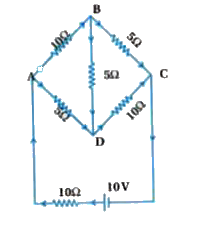
View SolutionAt a place on earth the vertical component of earth's magnetic field is √3 times its horizontal component. The angle of dip at this place is …...
View SolutionFigures (a) and (b) show the field lines of a positive and negative point charge respectively
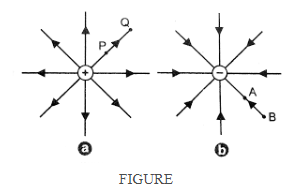
(a) Give the signs of the potential difference VP−VQ,VB–VA.
(b) Give the sign of the potential energy difference of a small negative charge between the points Q and P, A and B.
(c) Give the sign of the work done by the field in moving a small positive charge from Q to P.
(d) Give the sign of the work done by the external agency in moving a small negative charge from B to A.
(e) Does the kinetic energy of a small negative charge increase or decrease in going from B to A?
View Solution(a) तथा (b) में क्रमश : एकल धन तथा ऋण आवेशों की क्षेत्र रेखाएँ दर्शायी गई हैं
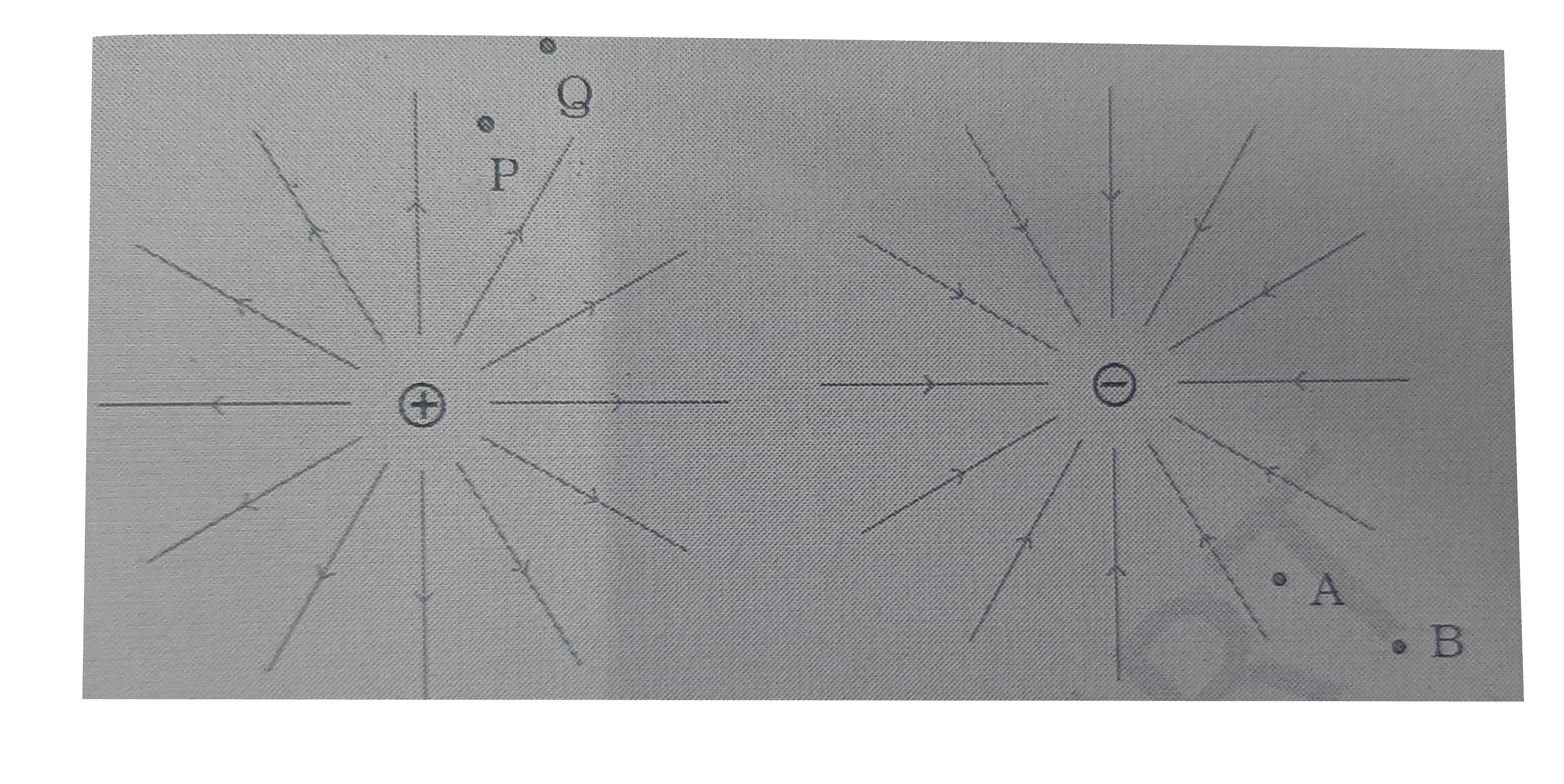
(a) विभवांतर VP−VQ:VB−VA के चिन्ह बताइए।
(b) बिंदु Q और P : A और B के बीच एक छोटे से ऋण आवेश की स्थितिज ऊर्जा के अंतर का चिन्ह बताइए ।
(c) Q से P तक एक छोटे धनावेश को ले जाने में क्षेत्र द्वारा किय गए कार्य का चिन्ह बताइए।
(d) B से A तक एक छोटे से ऋण आवेश को ले जाने के लिए बाह्म साधन द्वारा किए गए कार्य का चिन्ह बताइए ।
(e) B से A तक जाने में क्या एक छोटे से ऋणावेश की गतिज ऊर्जा बढ़ेगी या घटेगी ?
View SolutionGive the sign of the potentiaol energy difference of a small negative charge between the points Q and P,A and B.
View Solutionचित्र a और b में क्रमश: एकल धन एव ऋण आवेशों की क्षेत्र रेखाओ प्रदर्शित की गयी है

बिंदु Q और P तथा A और B के बिच एक छोटे से ऋणावेशी की स्थितिज ऊर्जा के अंतर का चिन्ह बताइये।
View Solutionचित्र a तथा b में क्रमशः एकल धन तथा ऋण आवेशों की क्षेत्र रेखाएं दर्शायी गई हैं।

a. विभवांतर VP−VQ,VB−VA के चिन्ह बताइए।
b. बिंदु O और P,A और B के बीच एक छोटे से ऋण आवेश की स्थितिज ऊर्जा के अंतर का चिन्ह बताइए।
c. Q से P तक एक छोटे धनावेश को ले जाने में क्षेत्र द्वारा किये गय कार्य का चिन्ह बताइए।
d. B से A तक एक छोटे से ऋण आवेश को ले जाने के लिए बाह्य साधन द्वारा किए गए कार्य का चिन्ह बताइए।
e. B से A तक जाने में क्या एक छोटे से ऋणावेश की गतिज ऊर्जा बढ़ेगी या घटेगी?
View SolutionFigure (a) and (b) show the field lines of a positive and negative point charge respectively. (a) Give the signs of the potential difference . V_(p)-V_(Q), V_(B)-V_(A) (b) Give the sign of the potential energy difference if a small negative charge is moved from points Q to P from point A to B. (c) Give the sign of the work done by the field in moving a small positive charge from Q to P. ( d) Give the sign of the work done by the external agency in moving a samall negative charge from B to A . (e ) Does the kinetic energy of a small negative charge increase or decrease in going from B to A ?
View SolutionFigures (a) and (b) show the field lines of a positive and negative point charge respectively.
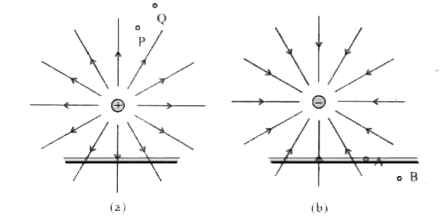
(a). Gives the sign of the potential difference VP−VQ:VB−VA
(b) Given the sign of the potential energy difference of a small negative charge between the points Q and P, A and b
(c) Give the sign of the work done by the field in moving a small positive charge from Q to P.
(d) Give the sign of the work done by external agencyin moving a small negative charge from B to A.
(e) Does the kinetic energy of a small negative charge increase or decrease in going from B to A?
View SolutionFigures 2.8 (a) and (b) show the field lines of a positive and negative point charge respectively. (a) Give the signs of the potential difference V_(P)-V_(Q): V_(B)-V_(A) . (b) Give the sign of the potential energy difference of a small negative charge between the points Q and P, A and B. (c) Give the sign of the work done by the field in moving a small positive charge from Q to P. (d) Give the sign of the work done by the external agency in moving a small negative charge from B to A. (e) Does the kinetic energy of a small negative charge increase or decrease in going from B to A?
View SolutionFigures 2.8 (a) and (b) show the field lines of a positive and negative point charge respectively. (a) Give the signs of the potential difference V_(P)-V_(Q): V_(B)-V_(A) . (b) Give the sign of the potential energy difference of a small negative charge between the points Q and P, A and B. (c) Give the sign of the work done by the field in moving a small positive charge from Q to P. (d) Give the sign of the work done by the external agency in moving a small negative charge from B to A. (e) Does the kinetic energy of a small negative charge increase or decrease in going from B to A?
View SolutionFigures (a) and (b) show the field lines of a positive and negative point charge respectively. (a) Give the signs of the potential difference V_(P)-V_(Q), V_(B)-V_(A) . (b) Give the sign of the potential energy difference of a small negative charge between the points Q and P, A and B. (c) Give the sign of the work done by the field in moving a small positive charge from Q to P. (d) Give the sign of the work done by the external agency in moving a small negative charge from B to A. (e) Does the kinetic energy of a small negative charge increase or decrease in going from B to A?
View SolutionFig (a) and (b) show the field lines of a single positive and negative charges respectively .
Give the signs of the potential difference : VP−VQ,VB−VA
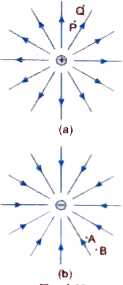
View Solution
